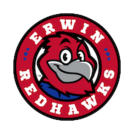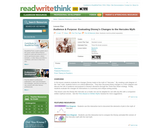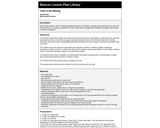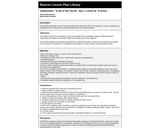
This resource is to help students learn how to sequence events in story.
- Subject:
- Reading Foundation Skills
- Material Type:
- Activity/Lab
- Author:
- MEGHAN PENNY
- Carrie Robledo
- Date Added:
- 03/25/2022

This resource is to help students learn how to sequence events in story.

This parent guide supports parents in helping their child at home with the 5th grade ELA content. Within the folder you will access Parent Guide PDFs in FIVE Languages: Arabic, English, Hindi, Spanish, and Vietnamese to help on-going communication with caregivers.

This lesson employs direct instruction and small-group discussion to help students learn new vocabulary skills while reading Patricia Polacco?s Pink and Say.

What drives changes to classic myths and fables? In this lesson students evaluate the changes Disney made to the myth of "Hercules" in order to achieve their audience and purpose.

Tradition in the Lakota Sioux involves giving a name to a child based on his actions, so a young child who moves slowly in all he does earns the name ‘Slow’ from his family. After demonstrating bravery and determination during battle he then earns a new name, Sitting Bull, and this same man later becomes the respected chief of the Lakota Sioux. In this CCSS lesson students will explore Sitting Bull's life through text dependent questions, academic vocabulary, and writing assignments.

Students examine books, selected from the American Library Association Challenged/Banned Books list, and write persuasive pieces expressing their views about what should be done with the books at their school.

How do cells keep us alive? Through reading and hands-on activities, students learn about parts of a cell, and their functions in carrying out processes for life. Study skills are taught and modeled as students make entries in science notebooks.

Students will use literary elements to show similarities and differences of today's society to the past. Using the book, Belle Prater's Boy by Ruth White students will be able to compare and contrast the characters Gypsies and Woodrows dilemmas in life to situations taking place in the home, society, and school today.

Based on the Guided Comprehension Model developed by Maureen McLaughlin and Mary Beth Allen, this lesson introduces students to the comprehension strategy of monitoring.

This unit is designed for students to learn to make judgments and decisions based on facts, and to use informational and imaginative speech to present their personal viewpoint and opinion to others. Students experience, first hand, taxation without representation, and will develop a very real sense for the need to preserve the inherent freedoms of man. Using the American flag as a graphic organizer, students will develop a clear understanding of the actions and reactions of the American colonists to British rule and to our most important national holiday, the 4th of July. Historically significant events will be studied and organized through exploration of facts and opinions and interaction with informational text and class discussion.

Students will read a biography about President Lincoln's life and write a summary based on the passage This resource supports English language development for English language learners.

Students will read a passage; read and match vocabulary and characters with descriptors; write responses to questions; read excerpts and write the Standard English version; write textual evidence as support; and write about a character's viewpoint. This resource supports English language development for English language learners.

Students will read a description of and passage from one of Aesop's works, events, questions, vocabulary, definitions, idioms, and a writing prompt. Students will write short answers, quotations to support a main idea, and an essay. This resource supports English language development for English language learners.

Students will read a passage and examples, and then write to answer questions and apply a strategy based on the passage. This resource supports English language development for English language learners.

Students will read a passage and write textual evidence to support a main idea. This resource supports English language development for English language learners.

Students will read a passage and write to answer questions based on the passage. This resource supports English language development for English language learners.

Students will read a passage and use context clues to determine the meanings of words. This resource supports English language development for English language learners.

Students will read background information and a passage. Students will then read questions and write answers to the questions. This resource supports English language development for English language learners.

Students will read a passage, write answers to questions based on the passage, and write to explain and justify their position. This resource supports English language development for English language learners.

Students will read "If," write to explain, read and analyze the text for character traits and vocabulary, write examples of figurative language, write quotes to support a main idea, and write a narrative. This resource supports English language development for English language learners.